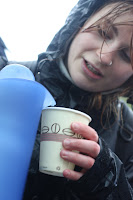17-24 June 2010
The Swedish Sub-Arctic and the Sub-Antarctic French territories provide important opportunities for comparisons and further scientific investigations.
In this regard, the 2010 summer school stands as a joint initiative of the French Polar Institute (IPEV) and the Swedish Polar Research Secretariat, the support of CNRS (the French National Center for Scientific Research) and the French Embassy in Sweden.
The summer school will offer the opportunity for scientists, young researchers and students to share their views and experiences on the climate change and impacts on sub-polar ecosystems, laying down the basis for future joint research.

 Françoise Hennion followed by a lecture not about insects but about plants in the sub-antarctic regions. She mainly spoke about their response to climate change. Françoise Hennion is a CNRS (French National Center of Scientific Research) researcher.
Françoise Hennion followed by a lecture not about insects but about plants in the sub-antarctic regions. She mainly spoke about their response to climate change. Françoise Hennion is a CNRS (French National Center of Scientific Research) researcher. We spent the afternoon at the Stordalen Mire (Torneträsk lake) where Erik Lundin told us about his research on carbon turnover in subarctic aquatic systems. He showed us his measure instruments on field. Then, we met Patrick Crill who explained us the mechanisms of permafrost in the region.
We spent the afternoon at the Stordalen Mire (Torneträsk lake) where Erik Lundin told us about his research on carbon turnover in subarctic aquatic systems. He showed us his measure instruments on field. Then, we met Patrick Crill who explained us the mechanisms of permafrost in the region.








No comments:
Post a Comment